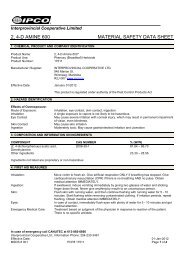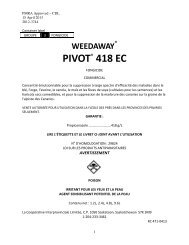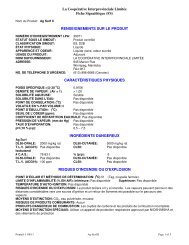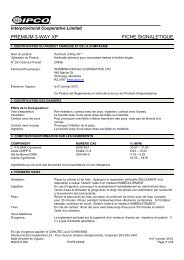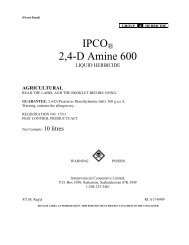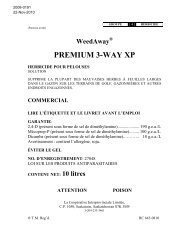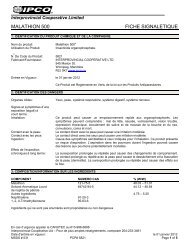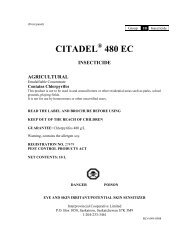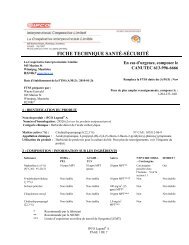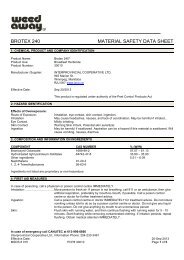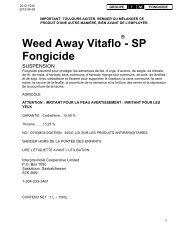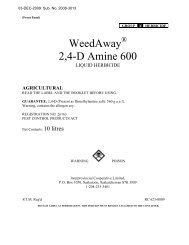IPCO MCPA AMINE 500
IPCO MCPA AMINE 500
IPCO MCPA AMINE 500
Create successful ePaper yourself
Turn your PDF publications into a flip-book with our unique Google optimized e-Paper software.
(Booklet)Group 4 Herbicide<strong>IPCO</strong> ®<strong>MCPA</strong> <strong>AMINE</strong> <strong>500</strong>LIQUID HERBICIDEAGRICULTURALREAD THE LABEL BEFORE USINGGUARANTEE: <strong>MCPA</strong> <strong>500</strong> g a.e./L(Present as dimethylamine salt)Warning, contains the allergen soy.REGISTRATION NO: 20308PEST CONTROL PRODUCTS ACTNET CONTENTS: 10 litresWARNINGPOISONInterprovincial Cooperative Limited, P.O. Box 1050, Saskatoon, Saskatchewan S7K 3M91-204-233-3461®T.M. Reg’d.RC 601-0909
Crop:Treatment Stage:Susceptible Weeds:SECTION 2FLAX (LINSEED) (Excluding low-linolenic acid varieties)Ground or air application. Treat after plants reach 5 cm in height and before budding.Burdock, Cocklebur, Mustards (except Dog Mustard), Ragweed, Flixweed*, Kochia,Lamb’s-quarters, Russian Pigweed, Shepherd’s Purse, Stinkweed.*Flixweed susceptible only at seedling stage. Use rates for harder to kill weeds to killfall germinated flixweed in the spring.Rates to Use on Susceptible Weeds:Small seedlings, good growing conditions:Weeds in bud, adverse weather,heavy infestation:Crop:Treatment Stage:NOTE: Rates above 850 mL/ha may cause injury.Do not apply more than once per year.SECTION 3WINTER WHEAT, FALL RYE700 mL/ha1.1 L/haGO TO SECTION 8Ground or air application. Treat in Spring from time crop commences growth to flagleaf stage.NOTE: 1. Do not treat crops underseeded to legumes.2. Doses above <strong>500</strong> mL/ha applied between the 3rd and 6th leaf may causeinjury.Susceptible Weeds:Burdock, Cocklebur, Mustards (except Dog Mustard), Ragweed, Flixweed*, Kochia,Lamb’s-quarters, Russian Pigweed, Shepherd’s Purse, Stinkweed.*Flixweed susceptible only at seedling stage. Use rates for harder to kill weeds to killfall germinated flixweed in the spring.Rates to Use on Susceptible Weeds:Susceptible weeds, good growing conditions: 550 mL/haWeeds in bud, adverse conditions, heavy infestations: 1.1 L/haDo not apply more than once per year.GO TO SECTION 8SECTION 4Crop:GRASS PASTURES (Established)Treatment Stage:Ground or air application. Treat in Spring or Fall (good growing conditions) for bestresults.Susceptible Weeds:Bluebur, Cocklebur, Plaintain, Creeping Buttercup, Flixweed, Kochia, Horsetail,Lamb’s-quarters, Mustards, Prickly Lettuce, Ragweed, Russian Pigweed, Shepherd’sPurse, Stinkweed, Wild Radish.Rates to Use on Susceptible Weeds:2 L/haHarder to Kill Weeds:Blue Lettuce*, Canada Thistle*, Curled Dock, Dandelions, Dog Mustard, Goatsbeard,Goosefoot, Hempnettle (Suppression), Leafy Spurge, Peppergrass, Redroot Pigweed,Sow Thistle*, Tumbleweed.*Top Kill Only.
Rates to use on Harder to Kill Weeds:3.5 L/haDo not apply more than twice per season, with a minimum retreatment interval of 90days.GO TO SECTION 8Crop:Treatment Stage:Susceptible Weeds:SECTION 5CORN (Field and Sweet)Rates to Use:Small seedlings, good growing conditions:Larger weeds, adverse conditions, heavy infestation:Crop:Treatment Stage:Susceptible Weeds:Ground Application ONLY. Treat before corn is 15 cm high.Controls Atrazine resistant and other susceptible broadleaf weeds. (See Section 1 forlist of weeds.)750 mL/ha1.25 L/haDo not apply more than once per year.For hand harvesting of corn (field and sweet), re-entry is not permitted until 15 daysafter application. As such, a preharvest interval (PHI) of 15 days after application isrequired.GO TO SECTION 8SECTION 6PEAS, FIELD AND CANNING (Except Nova Scotia). Do not combine withMalathion.Spray when vine length is 10-20 cm. DO NOT APPLY BY AIR.Mustards (except Dog Mustard), Ragweed, Flixweed, Kochia, Lamb’s-quarters,Russian Pigweed, Shepherd’s Purse, Stinkweed.Rates to Use:Small seedlings, good growing conditions:330 mL/haLarger weeds, adverse conditions, heavy infestations:550 mL/haGO TO SECTION 8SECTION 7Tank Mixes with <strong>IPCO</strong> <strong>MCPA</strong> Amine <strong>500</strong>Use tank mixes only when they are registered and recommended. Read and follow all label directions on both products usedin a tank mix. Ensure all components of tank-mix are registered for aerial application.1. TANK MIX <strong>IPCO</strong> <strong>MCPA</strong> Amine <strong>500</strong> + Banvel II HerbicideCrop:Treatment Stage:Susceptible Weeds:WHEAT, BARLEYSee <strong>MCPA</strong> and Banvel II Herbicide labels.Weeds susceptible to <strong>MCPA</strong> plus Canada and Sow Thistle, Wild Buckwheat, GreenSmartweed, Cow Cockle, Hempnettle, Lady’s-thumb.Rates to Use: Wheat: <strong>IPCO</strong> <strong>MCPA</strong> Amine <strong>500</strong> 750 mL/ha+ Banvel II Herbicide + 290 mL/haBarley: <strong>IPCO</strong> <strong>MCPA</strong> Amine <strong>500</strong> 850 mL/ha+ Banvel II Herbicide + 230 mL/haGO TO SECTION 8
2. TANK MIX IN WESTERN CANADA ONLY<strong>IPCO</strong> <strong>MCPA</strong> Amine <strong>500</strong> + Sencor® <strong>500</strong>Crop:Treatment Stage:Susceptible Weeds:SPRING BARLEY, SPRING WHEATAfter weeds emerge and crop is in the 3-5 leaf stage.<strong>MCPA</strong> susceptible weeds plus, Hempnettle, Chickweed, Volunteer Rapeseed, TartaryBuckwheat.Rates to Use: Barley: <strong>IPCO</strong> <strong>MCPA</strong> Amine <strong>500</strong> 1 L/ha+ Sencor <strong>500</strong> + 275-<strong>500</strong> mL/haWheat: <strong>IPCO</strong> <strong>MCPA</strong> Amine <strong>500</strong> 1 L/ha+ Sencor <strong>500</strong> +275-425 mL/haGO TO SECTION 8SECTION 8MIXING AND APPLICATION INSTRUCTIONS1. Fill tank 1/2 full with water. Start agitation.2. Add <strong>IPCO</strong> <strong>MCPA</strong> Amine <strong>500</strong>. For tank mixes, add <strong>MCPA</strong> first, then the second herbicide.3. Complete filling of tank with water.4. Use 100-240 litres of water per hectare for application by ground equipment unless otherwise specified.5. Do not exceed 275 kPa pressure for ground application.Field Sprayer Application: DO NOT apply during periods of dead calm. Avoid application of this product when winds aregusty. DO NOT apply with spray droplets smaller than the American Society of Agricultural Engineers (ASAE) coarseclassification. Boom height must be 60 cm or less above the crop or ground.Aerial Application: DO NOT apply during periods of dead calm. Avoid application of this product when winds are gusty.DO NOT apply when wind speed is greater than 16 km/h at flying height at the site of application. DO NOT apply withspray droplets smaller than the American Society of Agricultural Engineers (ASAE) coarse classification. To reduce driftcaused by turbulent wingtip vortices, the nozzle distribution along the spray boom length MUST NOT exceed 65% of thewing- or rotorspan.Buffer Zones to Protect Sensitive HabitatUse of the following spray methods or equipment DO NOT require a buffer zone: hand-held or backpack sprayer and spottreatment.The buffer zones specified in the table below are required between the point of direct application and the closest downwindedge of sensitive terrestrial habitats (such as grasslands, forested areas, shelter belts, woodlots, hedgerows, riparian areas andshrublands), sensitive freshwater habitats (such as lakes, rivers, sloughs, ponds, prairie potholes, creeks, marshes, streams,reservoirs and wetlands), and estuarine/marine habitats.When a tank mixture is used, consult the labels of the tank-mix partners and observe the largest (most restrictive) buffer zoneof the products involved in the tank mixture.
Method ofApplicationField Sprayer*AerialCropCereals, flax, grass pastures(established), corn (field andsweet), peas (field and canning)Cereals, flaxBuffer Zones (metres) Required for the Protection of:Freshwater Habitat ofDepths:Estuarine/MarineHabitats of Depths:TerrestrialHabitatLess than Greater Less than Greater1 m than 1 m 1 m than 1 m1 1 1 1 4Fixed wing 1 0 1 0 60Rotary wing 1 0 1 0 50Grass pastures Fixed wing 5 1 1 1 100(established) Rotary wing 4 1 1 1 80*For field sprayer application, buffer zones can be reduced with the use of drift reducing spray shields. When using aspray boom fitted with a full shield (shroud, curtain) that extends to the crop canopy, the labelled buffer zone can bereduced by 70%. When using a spray boom where individual nozzles are fitted with cone-shaped shields that are nomore than 30 cm above the crop canopy, the labelled buffer zone can be reduced by 30%.Use Precautions for Aerial Application (to cereal crops, flax and established pastures):1. Aerial applicators must wear long pants and a long-sleeved shirt.2. Mixers/loaders must wear long pants, a long-sleeved shirt and chemical-resistant gloves during mixing, loading, cleanupand repair activities.3. Aircraft must use a closed cab.4. Mixer/loader and applicator must be different individuals.5. Use special care in aerial application where damage from drift can be greater.6. Avoid direct applications to any body of water. Do not contaminate water through spray drift or by cleaning ofequipment or disposal of wastes.7. A minimum volume of 30 L per hectare of spray solution should be used. Use boom pressure of 235 kPa or less. Avoidplacing nozzles where spray will enter wing tip vortices.8. Do not apply this product directly to, or otherwise permit it to come into direct contact with desirable crops or otherdesirable broadleaf plants or non-target species and do not permit spray mists to drift onto them.9. Coarse sprays are less likely to drift. Use only nozzles or nozzle configuration which minimize the production of finespray drops. Do not angle nozzles forward into the airstream and do not increase spray volume by increasing nozzlepressure. When spraying avoid combinations of pressures and nozzle type that will result in fine particles (mist) whichare more likely to drift. A spray thickening agent or drift retardant may be used with this product to aid in reducing spraydrift.10. Do not use human flaggers.11. Avoid spray drift: Appy only when there is little or no hazard from spray drift. Small quantities of the spray, which maynot be visible, may seriously injure susceptible crops and damage sensitive non-target habitat. A method must be used todetect air movement, lapse conditions, or temperature inversions (stable air) such as the use of balloons or a continuoussmoke column at or near the spray site or a smoke generator on the spray equipment. If the smoke develops into layersor indicates a potential for hazardous spray drift, do not spray. Do not spray in winds exceeding 8 km per hour.12. Buffer zones: Appropriate buffer zones should be established between treatment areas and aquatic systems and treatmentareas and significant wildlife habitat.GO TO SECTION 9
SECTION 9PRECAUTIONS:1. KEEP OUT OF REACH OF CHILDREN. Do not use in residential areas, which are defined as sites wherebystanders may be present during or after spraying, including homes, schools, parks, playgrounds, playing fieldsand public buildings.2. Mixers, loaders, and applicators must wear a long-sleeved shirt, long pants, socks, shoes and chemical-resistantgloves. Aerial applicators and applicators using a closed cab are not required to wear chemical-resistant gloves.3. Avoid contact with eyes, skin and clothing. May cause skin irritation.4. Do not breathe spray mist or vapors. Avoid spray or vapor drifts onto susceptible plants such as grapes, tomatoes,tobacco, sugar beets, sunflowers, beans, turnips, cauliflower, cabbage, alfalfa, clover, peas, potatoes, ornamentaltrees, shrubs or flowers, fruit trees, lawns, most vegetable crops or other desirable vegetation.5. Do not spray when there is any danger of wind or on exceptionally hot days over 27˚C.6. Drift from spray may be reduced by using high volume sprays under low pressure, coarse sprays, and drop nozzleswhere possible. Use special care in aerial application where damage from drift can be greater.7. Do not contaminate any body of water. Avoid contamination of foods.8. Do not use in a greenhouse.9. Keep in original container during storage.10. Do not store near or in same room as seeds, feeds, fertilizers or pesticides used on crops sensitive to this product.11. Clean spray equipment thoroughly after use and rinse with clean water. Do not use spray equipment to apply otherpesticides to crops sensitive to this product. Do not re-use empty containers.12. Do not enter treated areas within 12-hours after application, unless otherwise indicated.13. Do not permit lactating dairy animals to graze fields within 7 days after application.14. Do not harvest for forage or cut hay within 7 days after application.15. Withdraw meat animals from treated fields at least 3 days before slaughter.16. If this pest control product is to be used on a commodity that may be exported to the U.S. and you requireinformation on acceptable residue levels in the U.S., visit CropLife Canada’s web-site at www.croplife.ca.ENVIRONMENTAL HAZARDS:Toxic to aquatic organisms and non-target terrestrial plants. Observe buffer zones specified under DIRECTIONS FOR USE.Surface runoffTo reduce runoff from treated areas into aquatic habitats, consider the characteristics and conditions of the site beforetreatment. Site characteristics and conditions that may lead to runoff include, but are not limited to, heavy rainfall, moderateto steep slope, bare soil, poorly draining soil (e.g. soils that are compacted, fine-textured, or low in organic matter such asclay).Avoid applying this product when heavy rain is forecast.Contamination of aquatic areas as a result of runoff may be reduced by including a vegetative strip (buffer zone) between thetreated area and the edge of the water body.LeachingThe use of this chemical may result in contamination of groundwater particularly in areas where soils are permeable (e.g.sand, loamy sand and sandy loam soils) and/or the depth to the water table is shallow.RESISTANCE MANAGEMENT RECOMMENDATIONS:For resistance management, <strong>IPCO</strong> <strong>MCPA</strong> Amine <strong>500</strong> is a Group 4 herbicide. Any weed population may contain or developplants naturally resistant to <strong>IPCO</strong> <strong>MCPA</strong> Amine <strong>500</strong> and other Group 4 herbicides. The resistant biotypes may dominate theweed population if these herbicides are used repeatedly in the same field. Other resistance mechanisms that are not linked tosite of action, but specific for individual chemicals, such as enhanced metabolism, may also exist. Appropriate resistancemanagementstrategies should be followed.
To delay herbicide resistance: Where possible, rotate the use of <strong>IPCO</strong> <strong>MCPA</strong> Amine <strong>500</strong> or other Group 4 herbicides withdifferent herbicide groups that control the same weeds in a field. Use tank mixtures with herbicides from a different groupwhen such use is permited. Herbicide use should be based on an IPM program that includes scouting, historical informationrelated to herbicide use and crop rotation, and considers tillage (or other mechanical), cultural, biological and other chemicalcontrol practices. Monitor treated weed populations for resistance development. Prevent movement of resistant weed seeds toother fields by cleaning harvesting and tillage equipment and planting clean seed. Contact your local extension specialist orcertified crop advisors for any additional pesticide resistance-management and/or integrated weed-managementrecommendations for specific crops and weed biotypes. For further information or to report suspected resistance, contactInterprovincial Cooperative Ltd. at 1-204-233-3461.GO TO SECTION 10SECTION 10FIRST AID:1. If on skin or clothing, take off contaminated clothing. Rinse skin immediately with plenty of water for 15-20 minutes.Call a poison control centre or doctor for treatment advice.2. If in eyes, hold eye open and rinse slowly and gently with water for 15-20 minutes. Remove contact lenses, if present,after the first 5 minutes, then continue rinsing eye. Call a poison control centre or doctor for treatment advice.3. If swallowed, call a poison control centre or doctor immediately for treatment advice. Have person sip a glass of water ifable to swallow. Do not induce vomiting unless told to do so by a poison control centre or doctor. Do not give anythingby mouth to an unconscious person.4. If inhaled, move person to fresh air. If person is not breathing, call 911 or an ambulance, then give artificial respiration,preferably by mouth-to-mouth, if possible. Call a poison control centre or doctor for further treatment advice.5. Take container, label or product name and Pest Control Product Registration Number with you when seeking medicalattention.GO TO SECTION 11SECTION 11TOXICOLOGICAL INFORMATION:High concentrations of <strong>MCPA</strong> may cause severe irritation to the eyes. Symptoms of overexposure to <strong>MCPA</strong> could includeslurred speech, twitching, jerking and spasms, drooling, low blood pressure and unconsciousness. No specific antidote.Treatment of any systemic intoxication should be primarily symptomatic and supportive.GO TO SECTION 12SECTION 12DISPOSAL INFORMATION:Do not reuse this container for any purpose. This is a recyclable container, and is to be disposed of at a container collectionsite. Contact your local distributor/dealer or municipality for the location of the nearest collection site.Before taking the container to the collection site:1. Triple- or pressure-rinse the empty container. Add the rinsings to the spray mixture in the tank.2. Make the empty, rinsed container unsuitable for further use.If there is no container collection site in your area, dispose of the container in accordance with provincial requirements. Forinformation on disposal of unused, unwanted product, contact the manufacturer or the provincial regulatory agency. Contactthe manufacturer and the provincial regulatory agency in case of a spill, and for clean-up of spills.NOTICE TO USER:This pest control product is to be used only in accordance with the directions on the label. It is an offence under the PestControl Products Act to use this product in a way that is inconsistent with the directions on the label. The user assumes therisk to persons or property that arises from any such use of this product.
(Base Label)Group 4 Herbicide<strong>IPCO</strong> ®<strong>MCPA</strong> <strong>AMINE</strong> <strong>500</strong>LIQUID HERBICIDEAGRICULTURALREAD THE LABEL BEFORE USINGGUARANTEE: <strong>MCPA</strong> <strong>500</strong> g a.e./L(Present as dimethylamine salt)Warning, contains the allergen soy.REGISTRATION NO: 20308PEST CONTROL PRODUCTS ACTNET CONTENTS: 10 litresWARNINGPOISONInterprovincial Cooperative Limited, P.O. Box 1050, Saskatoon, Saskatchewan S7K 3M91-204-233-3461®T.M. Reg’d.RC 601-0909
(Back Panel)PRECAUTIONS:1. KEEP OUT OF REACH OF CHILDREN. Do not use in residential areas, which are defined as sites where bystandersmay be present during or after spraying, including homes, schools, parks, playgrounds, playing fields and publicbuildings.2. Mixers, loaders, and applicators must wear a long-sleeved shirt, long pants, socks, shoes and chemical-resistant gloves.Aerial applicators and applicators using a closed cab are not required to wear chemical-resistant gloves.3. Avoid contact with eyes, skin and clothing. May cause skin irritation.4. Do not breathe spray mist or vapors. Avoid spray or vapor drifts onto susceptible plants such as grapes, tomatoes,tobacco, sugar beets, sunflowers, beans, turnips, cauliflower, cabbage, alfalfa, clover, peas, potatoes, ornamental trees,shrubs or flowers, fruit trees, lawns, most vegetable crops or other desirable vegetation.5. Do not spray when there is any danger of wind or on exceptionally hot days over 27˚C.6. Drift from spray may be reduced by using high volume sprays under low pressure, coarse sprays, and drop nozzleswhere possible. Use special care in aerial application where damage from drift can be greater.7. Do not contaminate any body of water. Avoid contamination of foods.8. Do not use in a greenhouse.9. Keep in original container during storage.10. Do not store near or in same room as seeds, feeds, fertilizers or pesticides used on crops sensitive to this product.11. Clean spray equipment thoroughly after use and rinse with clean water. Do not use spray equipment to apply otherpesticides to crops sensitive to this product. Do not re-use empty containers.12. Do not enter treated areas within 12-hours after application, unless otherwise indicated.13. Do not permit lactating dairy animals to graze fields within 7 days after application.14. Do not harvest for forage or cut hay within 7 days after application.15. Withdraw meat animals from treated fields at least 3 days before slaughter.16. If this pest control product is to be used on a commodity that may be exported to the U.S. and you require informationon acceptable residue levels in the U.S., visit CropLife Canada’s web-site at www.croplife.ca.FIRST AID:1. If on skin or clothing, take off contaminated clothing. Rinse skin immediately with plenty of water for 15-20 minutes.Call a poison control centre or doctor for treatment advice.2. If in eyes, hold eye open and rinse slowly and gently with water for 15-20 minutes. Remove contact lenses, if present,after the first 5 minutes, then continue rinsing eye. Call a poison control centre or doctor for treatment advice.3. If swallowed, call a poison control centre or doctor immediately for treatment advice. Have person sip a glass of waterif able to swallow. Do not induce vomiting unless told to do so by a poison control centre or doctor. Do not giveanything by mouth to an unconscious person.4. If inhaled, move person to fresh air. If person is not breathing, call 911 or an ambulance, then give artificial respiration,preferably by mouth-to-mouth, if possible. Call a poison control centre or doctor for further treatment advice.5. Take container, label or product name and Pest Control Product Registration Number with you when seeking medicalattention.ENVIRONMENTAL HAZARDS: Refer to the attached booklet for complete environmental hazards.TOXICOLOGICAL INFORMATION:High concentrations of <strong>MCPA</strong> may cause severe irritation to the eyes. Symptoms of overexposure to <strong>MCPA</strong> could includeslurred speech, twitching, jerking and spasms, drooling, low blood pressure and unconsciousness. No specific antidote.Treatment of any systemic intoxication should be primarily symptomatic and supportive.DISPOSAL INFORMATION:Do not reuse this container for any purpose. This is a recyclable container, and is to be disposed of at acontainer collection site. Contact your local distributor/dealer or municipality for the location of thenearest collection site. Before taking the container to the collection site:(1) Triple - or pressure-rinse the empty container. Add the rinsings to the spray mixture in the tank.(2) Make the empty, rinsed container unsuitable for further use.If there is no container collection site in your area, dispose of the container in accordance with provincial requirements. Forinformation on disposal of unused, unwanted product, contact the manufacturer or the provincial regulatory agency. Contactthe manufacturer and the provincial regulatory agency in case of a spill, and for clean-up of spills.NOTICE TO USER: This pest control product is to be used only in accordance with the directions on the label. It is anoffence under the Pest Control Products Act to use this product in a way that is inconsistent with the directions on the label.The user assumes the risk to persons or property that arises from any such use of this product.RC 847-0909



